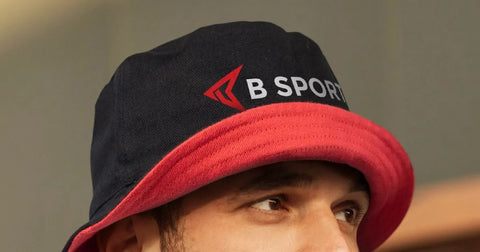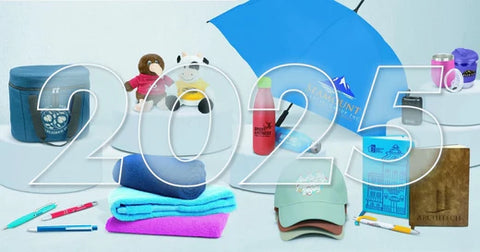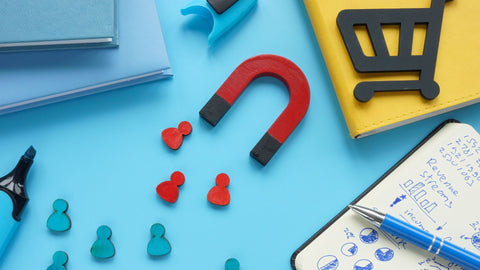Blog / Sales & Marketing / Promotional Products to Increase Brand Awareness
Promotional Products to Increase Brand Awareness

In the dynamic world of marketing, brand awareness play an important role in the success of any business. One potent tool that businesses can leverage to enhance brand visibility is the strategic use of promotional products. These tangible items not only leave a lasting impression but also serve as constant reminders of your brand. In this comprehensive guide, we explore the art of using promotional products to effectively boost brand awareness.
Table of Contents:
- Know Your Audience:
- Choose Practical and Relevant Items:
- Imprint Your Logo Effectively:
- Align with Your Brand Identity:
- Leverage Seasonal Opportunities:
- Create Limited Editions:
- Measure and Adapt:
1. Know Your Audience:

Before delving into the world of promotional products, it's crucial to have a deep understanding of your target audience. Consider their demographics, interests, and lifestyle. Tailoring your promotional items to resonate with your audience ensures a more significant impact on brand recall. Here are some tailored promotional product ideas for different audience segments:
College Students- Customized T-Shirts: Popular and wearable, featuring trendy designs and your logo.
- Reusable Water Bottles: Eco-friendly and practical, with a catchy design.
- Tech Accessories: Branded phone chargers, earbuds, or laptop stickers.
- High-Quality Notebooks: Stylish and functional for meetings and notes.
- Branded Pens: Elegant and useful, ideal for everyday use.
- Desk Accessories: Custom mouse pads, USB drives, or desk organizers.
- Branded Hats or Caps: Useful for outdoor activities and promoting sun safety.
- Insulated Travel Mugs: Keeps beverages hot or cold during adventures.
- Portable Phone Chargers: Essential for staying connected while on the go.
- Fitness Bands: Branded with your logo, encouraging an active lifestyle.
- Sports Bottles: Durable and perfect for workouts.
- Gym Bags: Useful for carrying gear and promoting your brand at the gym.
- Bluetooth Speakers: Branded and high-quality, for enjoying music anywhere.
- USB Hubs: Useful for connecting multiple devices.
- Stylus Pens: Great for tablets and touchscreen devices.
- Branded Backpacks: Useful for daily activities and promoting your brand.
- Lunch Boxes: Customizable with your logo, ideal for school kids.
- Plush Toys: Safe and fun, branded with your logo.
- Reusable Tote Bags: Practical and eco-friendly, ideal for shopping.
- Seed Packets: Encourage planting and sustainability with your logo.
- Bamboo Utensils: Portable and environmentally friendly.
- Lanyards: Customizable and essential for event identification.
- Promotional Badges: Wearable and visible throughout the event.
- Branded Notepads: Useful for taking notes during sessions.
2. Choose Practical and Relevant Items:

Opt for promotional products that align with the daily lives of your audience. Practical items, such as pens, reusable bags, or tech gadgets, have a higher likelihood of being used regularly, increasing the exposure of your brand. But, don't forget about the quality! Invest in high-quality promotional items. Durable and well-crafted items not only reflect positively on your brand but also ensure that recipients will retain and use them, providing prolonged exposure.
Reusable Water Bottles- Why? Encourages hydration and eco-friendly habits.
- Target Audience: Broad appeal – students, professionals, fitness enthusiasts, and eco-conscious consumers.
- Why? Practical for carrying groceries, books, or gym gear, promoting eco-friendliness.
- Target Audience: Eco-conscious consumers, students, professionals, and event attendees.
- Why? Everyday essentials in a tech-driven world.
- Examples: Phone chargers, USB drives, and cable organizers.
- Target Audience: Tech-savvy individuals, professionals, and students.
- Why? Useful for note-taking in professional, academic, and personal settings.
- Target Audience: Professionals, students, and conference attendees.
3. Imprint Your Logo Effectively:

Your logo is the visual representation of your brand, and its placement on promotional products is crucial. Ensure that your logo is prominently and aesthetically displayed. Consider the color scheme and overall design to make it visually appealing. Here are some best practices for logo imprinting:
Optimal Logo Placement- Prominent Positioning: Place your logo in a visible and central location.
- Balanced Design: Ensure the logo does not overwhelm the product's overall design.
- Proportionality: Adjust the size of the logo to fit the product appropriately.
- Legibility: Ensure the logo is large enough to be easily read and recognized.
- Longevity: Opt for high-quality, durable materials that will last and keep your logo visible over time.
- Perception: Quality materials reflect well on your brand and improve perceived value.
4. Align with Your Brand Identity:

Promotional products should align with your brand identity. Whether it's the color scheme, messaging, or overall aesthetic, consistency reinforces brand recognition. Choose items that reflect the identity of your brand. Ensure your brand is easily recognizable by using consistent colors, fonts, and logos on all your promotional materials, including products. By maintaining consistency, the brand becomes easily recognizable and fosters a sense of trust with consumers. Here are some strategies and tips to ensure your promotional products effectively reflect your brand identity:
Understand Your Brand Identity- Core Values: Identify the core values and mission of your brand.
- Brand Personality: Determine the personality traits (e.g., professional, fun, eco-friendly) that define your brand.
- Visual Elements: Use consistent logos, colors, fonts, and design elements.
- Eco-Friendly Products: If sustainability is a key value, opt for reusable and eco-friendly items like tote bags, bamboo utensils, or stainless steel water bottles.
- Luxury Items: For a premium brand, select high-end products such as leather notebooks, metal pens, or branded tech gadgets.
- Fun and Playful Items: For a brand with a playful personality, consider colorful and fun items like custom t-shirts, novelty items, or quirky office supplies.
- Logo and Colors: Ensure your logo and brand colors are consistently used across all promotional products.
- Design Elements: Incorporate brand-specific design elements such as patterns, icons, or taglines that reinforce your brand identity.
- Packaging: Use packaging that reflects your brand's visual identity, including custom boxes, bags, or wrapping paper.
5. Leverage Seasonal Opportunities:

Capitalize on seasonal events and holidays to distribute themed promotional products. Whether it's branded sunglasses for summer or cozy blankets for winter, aligning your products with the season enhances relevance and memorability. Here are some strategies and examples to help you make the most of seasonal opportunities:
Identify Key Seasons and Holidays
- Major Holidays: Christmas, New Year, Easter, Halloween, Thanksgiving, etc.
- Seasonal Changes: Spring, Summer, Fall, Winter.
- Special Events: Back to School, Graduation, Valentine’s Day, Earth Day, etc.
Tailor Products to Seasonal Needs
- Relevance: Choose items that are useful and desirable during specific seasons.
- Timeliness: Distribute products well in advance of the season or holiday.
Create Themed Campaigns
- Holiday Themes: Incorporate holiday-specific colors, designs, and messages.
- Seasonal Messaging: Use seasonally relevant slogans and taglines that tie into your brand’s identity.
Bundle Products for Greater Impact
- Gift Sets: Create holiday gift sets or seasonal bundles that offer added value.
- Promotional Packages: Combine multiple items into themed packages for special events or holidays.
6. Create Limited Editions:

Generate excitement by creating limited-edition promotional products. Whether it's a special color, design, or functionality, exclusivity adds perceived value, making your brand more memorable. Here are some strategies and ideas for creating and leveraging limited edition promotional products:
Define the Purpose and Audience
- Target Audience: Identify who the limited edition products are aimed at (e.g., loyal customers, new prospects, event attendees).
- Objective: Determine the main goal (e.g., boosting sales, increasing brand loyalty, celebrating an event).
Choose Unique and High-Quality Items
- Uniqueness: Select products that stand out and aren’t commonly available.
- Quality: Ensure high-quality materials and craftsmanship to enhance perceived value.
Design with Exclusivity in Mind
- Limited Run: Produce a finite number of items to create scarcity.
- Special Features: Incorporate unique design elements, colors, or packaging exclusive to the limited edition.
Incorporate Branding Thoughtfully
- Logo Placement: Ensure your logo is prominently displayed without overwhelming the design.
- Themed Designs: Align the design with a specific theme, event, or campaign relevant to your brand.
7. Measure and Adapt:

Implement tracking mechanisms to measure the effectiveness of your promotional products. Analyze metrics such as website traffic, social media engagement, or customer inquiries to gauge the impact on brand awareness. Use these insights to tailor and improve your strategies.
Measuring the Effectiveness of Promotional Products
Set Clear Objectives- Brand Awareness: Increase in recognition and recall of your brand.
- Customer Engagement: Interaction with your brand, such as social media mentions or event participation.
- Sales and Conversions: Direct increase in sales or lead generation attributable to the promotional products.
- Customer Loyalty: Repeat purchases or increased engagement from existing customers.
Track Key Metrics
- Distribution and Reach: Number of products distributed and the demographic reach.
- Engagement Metrics: Social media likes, shares, mentions, and hashtag usage related to the promotional products.
- Website Traffic: Increase in website visits, particularly to pages related to the promotional campaign.
- Sales Data: Track any uptick in sales or conversions during and after the promotional period.
- Customer Feedback: Collect feedback through surveys, reviews, or direct comments on the promotional products.
Use Tracking Tools
- Unique Codes and QR Codes: Include unique codes or QR codes on the promotional products to track usage and redemptions.
- Google Analytics: Monitor website traffic and user behavior related to promotional campaigns.
- Social Media Analytics: Use tools like Facebook Insights, Instagram Analytics, and Twitter Analytics to track engagement.
Adapting Strategies Based on Insights
Refine Distribution Methods- Targeted Distribution: Focus on distributing products in channels that have proven most effective (e.g., specific events, online campaigns).
- Geographic Targeting: Consider geographic locations where the promotional products had the most impact.
Enhance Branding and Messaging
- Clearer Branding: Ensure that your logo and brand message are prominently displayed and easily recognizable.
- Consistent Messaging: Maintain consistent messaging across all promotional products to reinforce brand identity.
Optimize Marketing Campaigns
- Timing: Adjust the timing of your promotional campaigns to align with peak engagement periods.
- Cross-Promotions: Leverage successful products in cross-promotional campaigns with other marketing initiatives.
In conclusion, the strategic use of promotional products can significantly contribute to elevating brand awareness. By understanding your audience, choosing practical items, and aligning with your brand identity, you can create a powerful and lasting impact on your target market. Promotional products serve not only as giveaways but as tangible expressions of your brand values. Through thoughtful selection and creative engagement, businesses can turn these items into valuable assets for increased brand visibility and recognition.







